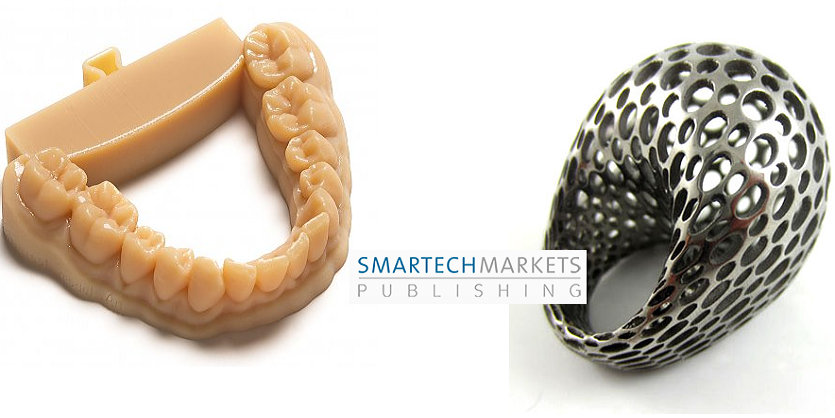SmarTech Publishing is known for their detailed industry reports pertaining to the 3D printing, scanning, materials, and software markets. With an eye on the future, their researchers and analysts are able to predict where a particular segment of the market will be years in the future. Usually I find that although hindsight is 20/20, foresight usually falls between 20/50 and 20/100. With that said, SmarTech has been doing a tremendous job at predicting the future of the market, certainly better than the average investor or business person like you or I could.
This week the company released two new industry reports, one analyzing and forecasting the growth of additive manufacturing within the dental industry, and the other concentrating on that of the jewelry and precious metals markets. Both reports show how significant a role additive manufacturing will play within each respected market moving forward.
“3D Printing in Dentistry 2015: A Ten Year Opportunity Forecast and Analysis” (Report found here)
Currently, additive manufacturing makes up a $780 million per year submarket within the dental industry. The technology is used for the fabrication of crowns, bridges, dental models, and even clear aligners. SmarTech expects the role of 3D printing to increase substantially over the next year, more than doubling to $2 billion by 2016, and rising further to $3.1 billion by 2020.
“This activity is expected to grow rapidly through increasing penetration of 3D print technology and new dental applications for 3D printing related to denture frameworks, custom trays, teaching models, implants, and others to reach $3.1 billion in revenues by 2020,” states SmartTech.
Included in that $3.1 billion estimate will be approximately $480 million in direct 3D printer sales to dental labs, doubling the $240 million figure that we currently are seeing. The recent availability and affordability of 3D scanners has played a major role and will continue to play a role in the expanded use of printing within the industry, as dentists and dental labs are able to cut costs, while providing a better product to their patients.
“Opportunities for 3D Printing Precious Metals: Jewelry and Other Applications” (Report found here)
There is little doubt that the jewelry industry has been slowly adopting 3D printing as a means of production. The technology allows designers to realize intricate pieces which never would have been possible using traditional design techniques. This report, which aims to present a 10-year forecast for the industry, splits into two different directions. One section discusses the use of additive manufacturing during the lost wax casting process, while another section looks towards the future and direct 3D printing of precious metals such as gold, silver, and platinum. Below are some of the highlights of the report’s findings:
- Polymer 3D printer hardware used in jewelry production is expected to double from $80 million currently, to $160 million by 2019, led by an increase in the number of sales of lower-priced machines.
- Demand for directly printed jewelry will cause the market for small powder bed fusion 3D printers to soar to $52 million by 2019 as companies seek to directly print jewelry without the need for casting.
- Current revenue from the printing of jewelry and fashion items using both polymer and a variety of metals is estimated to be $2.6 billion. SmarTech predicts this figure will jump over 400% by 2020 to $11 billion.
“The 3D printed jewelry industry is one of the oldest markets for 3D printing technologies, but is today facing disruption on multiple fronts, making it one of the most potentially exciting areas of 3D printing,” explained SmarTech in an email to us. “Disruption currently facing 3D printing jewelry markets includes introduction of systems for direct printing of jewelry and fashion items like timepiece components from precious metal powders. Additional disruption is occurring from increasingly capable low-cost photopolymerization printers which are enabling entrepreneurial growth in small-scale jewelry shops.”
There is little doubt that both these industries will witness incredible disruption over the next several years as these new manufacturing techniques inch their way into the fabrication process. Do you agree with SmarTech’s assessment on both markets? Let us know in the 3D Printing Dental and Jewelry Industry forum thread on 3DPB.com.
Subscribe to Our Email Newsletter
Stay up-to-date on all the latest news from the 3D printing industry and receive information and offers from third party vendors.
You May Also Like
Air Force Awards Fortius Metals $1.25M to Qualify 3D Printing Wire for Hypersonic Applications
AFWERX, part of the US Air Force Research Laboratory (AFRL), awarded a Direct-to-Phase II Small Business Innovation Research (SBIR) contract worth $1.25 million to Colorado’s Fortius Metals, to accelerate qualification...
US Air Force Awards JuggerBot $4M for Large-format Hybrid 3D Printing
Large-format 3D printer manufacturer JuggerBot has received a $4 million grant to develop a large format 3D printer, courtesy of the Under Secretary of Defense, Research and Engineering Manufacturing Technology...
Where Have All AM’s Unicorns Gone?
In the rapidly evolving world of 3D printing, startups valued at over a billion dollars, known as unicorns, once seemed as fantastical as the mythical creatures themselves. While a few...
How My Childhood Fascination with Planes Led to Investing in 3D Printing
My fascination with aerospace started young, and I started studying planes–identifying them in the sky and learning everything I could about how they work. Fast forward to my first week...
































